Sources
- Rosenthal, Harold and John Warrack (1979). The Concise Oxford Dictionary of Opera (2nd edition). London: Oxford University Press. ISBN 0-19-311318-X
Figaro Gets a Divorce is an opera by the Russian-British composer Elena Langer to a libretto by David Pountney. It premiered on 21 February 2016 at the Welsh National Opera at Cardiff. [1]
Figaro Gets a Divorce is conceived as a sequel [1] to Mozart's 1786 opera Le Nozze di Figaro (The Marriage of Figaro) based on the 1778 play La Folle Journée, ou Le Mariage de Figaro , [2] by Pierre Beaumarchais. This had been created by Beaumarchais as a sequel to his play Le Barbier de Séville . The latter was also set as the opera The Barber of Seville by Rossini in 1816 (itself preceded by other versions, including a 1782 setting by Giovanni Paisiello). Pountney, who in his capacity as Chief Executive and Artistic Director of the Welsh National Opera commissioned the composition, was inspired in his libretto by two different theatrical follow-ups to these two plays, Beaumarchais's own La Mère coupable (The Guilty Mother), and Ödön von Horváth's 1936 play, Figaro läßt sich scheiden (Figaro Gets a Divorce). [3] Both of these plays have previous operatic settings, the former by Darius Milhaud (1966), Inger Wikström (Den brottsliga modern, 1990 [4] ), and Thierry Pécou (2010), the latter by Giselher Klebe (1963). The opera takes the characters into the period of the French Revolution.
The opera was staged in Cardiff in sequence with the Rossini and Mozart operas, using the same set layout and many of the same singers. The set designs were by Ralph Koltai and Pountney himself directed all three operas. [3] After Cardiff the work was also seen in Birmingham, Llandudno, Bristol, Southampton, Milton Keynes and Plymouth. [5] Alongside the "febrile and glittery soundscape" Langer created for the Almavivas' flight from revolution, there was also her "jazzier style that added the lighter mood and the element of hope". [6]
Langer has said that in the new opera, the character of Cherubino (a sex-obsessed young teenager in the Mozart opera) has become 'sleazier'; the role (which is travesti in Mozart) is to be sung by a counter-tenor. [7] Pountney has said
It has been a great inspiration to imagine the future lives of these great characters of operatic and theatrical literature, to see how they might be tested by events and, in many cases, emerge as stronger and more admirable people. Of course all three operas should stand on their own, but the audience that is able to experience all three will, I hope, enjoy a truly rewarding operatic journey. [3]
| Role | Voice type | Premiere cast, 21 February 2016 (Conductor: Justin Brown) |
|---|---|---|
| Count | baritone | Mark Stone |
| Countess | soprano | Elizabeth Watts |
| Susanna | soprano | Marie Arnet |
| Figaro | baritone | David Stout |
| The Cherub | counter-tenor | Andrew Watts |
| Angelika, ward of the Count | soprano | Rhian Lois |
| Serafin, son of the Countess (travesti role) | mezzo-soprano | Naomi O'Connell |
| The Major | tenor | Alan Oke |
The Count is fleeing with his household from a revolution in an unspecified country and time. They are captured at the border by the enigmatic Major who seeks to bring them under his power. He informs Angelika and Serafin that they are in fact brother and sister, Angelika being the child of a liaison of the Count. He also knows that Serafin is in fact the result of a one-night stand between the Countess and Cherubino, who is reported killed in battle. The Major hopes to marry Angelika himself, and takes protection money from Figaro when the latter attempts to set up again as a barber. Figaro and Susanna quarrel, as Susanna wants a child and Figaro refuses to consider this in such turbulent times. Susanna encounters Cherubino, now known as 'The Cherub' and proprietor of a sleazy bar; he employs her as a chanteuse. The Countess refuses to be blackmailed by the Major and confesses Serafin's parentage to the Count. Susanna also confesses she is pregnant, with The Cherub as the father. Figaro helps the family to flee the clutches of the Major back to the Count's castle, in the process he shoots The Cherub. The Major, who is a double agent also working for the forces of the Revolution, seeks to trap the others in the castle and arrange for their murder. However Figaro, Susanna, Angelika and Serafin escape through a secret passage, whilst the Count and Countess remain behind to face the music. [8]
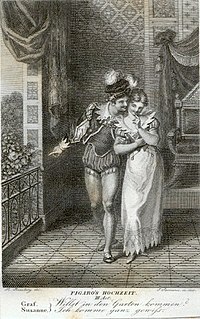
The Marriage of Figaro, K. 492, is an opera buffa in four acts composed in 1786 by Wolfgang Amadeus Mozart, with an Italian libretto written by Lorenzo Da Ponte. It premiered at the Burgtheater in Vienna on 1 May 1786. The opera's libretto is based on the 1784 stage comedy by Pierre Beaumarchais, La folle journée, ou le Mariage de Figaro. It tells how the servants Figaro and Susanna succeed in getting married, foiling the efforts of their philandering employer Count Almaviva to seduce Susanna and teaching him a lesson in fidelity.

Pierre-Augustin Caron de Beaumarchais was a French polymath. At various times in his life, he was a watchmaker, inventor, playwright, musician, diplomat, spy, publisher, horticulturist, arms dealer, satirist, financier, and revolutionary.
Welsh National Opera (WNO) is an opera company based in Cardiff, Wales; it gave its first performances in 1946. It began as a mainly amateur body and transformed into an all-professional ensemble by 1973. In its early days the company gave a single week's annual season in Cardiff, gradually extending its schedule to become an all-year-round operation, with its own salaried chorus and orchestra. It has been described by The New York Times as "one of the finest operatic ensembles in Europe".

The Barber of Seville or the Useless Precaution is a French play by Pierre Beaumarchais, with original music by Antoine-Laurent Baudron. It was initially conceived as an opéra comique, and was rejected as such in 1772 by the Comédie-Italienne. The play as it is now known was written in 1773, but, due to legal and political problems of the author, it was not performed until February 23, 1775, at the Comédie-Française in the Tuileries. It is the first play in a trilogy of which the other constituents are The Marriage of Figaro and The Guilty Mother.
The Ghosts of Versailles is an opera in two acts, with music by John Corigliano to an English libretto by William M. Hoffman. The Metropolitan Opera had commissioned the work from Corigliano in 1980 in celebration of its 100th anniversary, with the premiere scheduled for 1983. Corigliano and Hoffman took as the starting point for the opera the 1792 play La Mère coupable by Pierre Beaumarchais. They took seven years to complete the opera, past the initial deadline. The opera received its premiere on December 19, 1991, at the Metropolitan Opera, with the production directed by Colin Graham. The premiere run of seven performances was sold out. The original cast included Teresa Stratas, Håkan Hagegård, Renée Fleming, Graham Clark, Gino Quilico, and Marilyn Horne. The Metropolitan Opera revived the opera in the 1994/1995 season.

Hilde Güden or Gueden was an Austrian soprano who was one of the most appreciated Straussian and Mozartian sopranos of her day. Her youthful and lively interpretations made her an ideal interpreter of roles such as Zerbinetta in Ariadne auf Naxos and Susanna in Le nozze di Figaro.

The Marriage of Figaro is a comedy in five acts, written in 1778 by Pierre Beaumarchais. This play is the second in the Figaro trilogy, preceded by The Barber of Seville and followed by The Guilty Mother.
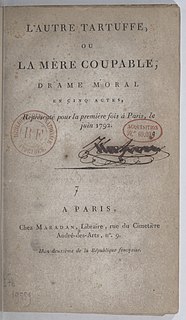
The Guilty Mother, subtitled The Other Tartuffe, is the third play of the Figaro trilogy by Pierre Beaumarchais; its predecessors were The Barber of Seville and The Marriage of Figaro. This was the author's last play. It is rarely revived. Like the earlier plays of the trilogy it has been turned into operatic form, but it has not entered the general opera repertoire.
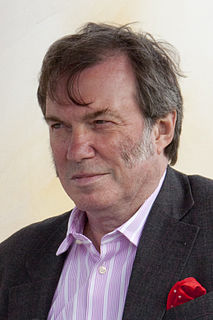
Sir David Willoughby Pountney is a British-Polish theatre and opera director and librettist internationally known for his productions of rarely performed operas and new productions of classic works. He has directed over ten world premières, including three by Sir Peter Maxwell Davies for whom he wrote the librettos of The Doctor of Myddfai, Mr Emmet Takes a Walk and Kommilitonen!

Figaro läßt sich scheiden, op.40, is an opera in two acts by Giselher Klebe based on the comedy of the same name by Ödön von Horváth. Klebe also wrote the libretto for this work.
Isabel Leonard is an American mezzo-soprano opera singer based in New York City. She is of Argentine ancestry on her mother's side.
Giuseppe Nessi was an Italian operatic tenor.
Gabor Carelli was a Hungarian classical tenor who had an important career in operas and concerts in North America during the mid-20th century. He was notably committed to the Metropolitan Opera in New York City from 1951 to 1974 where he gave a total of 1,079 performances. Music critic Elizabeth Forbes stated that he had "a lyrical voice, a stylish technique and an aptitude for comedy." In 1964 he joined the faculty of the Manhattan School of Music, where he taught singing and worked as an ensemble instructor until his death in Manhattan at the age of 83.

The Marriage of Figaro is a 1949 East German musical film directed by Georg Wildhagen and starring Angelika Hauff, Willi Domgraf-Fassbaender and Sabine Peters. It was based on the opera The Marriage of Figaro by Wolfgang Amadeus Mozart and Lorenzo Da Ponte, which was itself based on the play The Marriage of Figaro by Pierre Beaumarchais. The film was made by DEFA, the state production company of East Germany, in their Babelsberg Studio and the nearby Babelsberg Park. It sold 5,479,427 tickets.
"Non più andrai" is an aria for bass from Mozart's 1786 opera The Marriage of Figaro, K. 492. The Italian libretto was written by Lorenzo Da Ponte based on a stage comedy by Pierre Beaumarchais, La folle journée, ou le Mariage de Figaro (1784). It is sung by Figaro at the end of the first act.
Elena Langer is a Russian-born British composer of opera and other contemporary classical music. Her work has been performed at the Royal Opera House, Zurich Opera, Carnegie Hall, Richard B. Fisher Center for the Performing Arts, Stanislavski and Nemirovich-Danchenko Moscow Academic Music Theatre, Shakespeare's Globe, Wigmore Hall, Opera national du Rhin, Strasbourg, and Milton Court, Barbican Centre. She studied piano and composition at the Gnessin State Musical College in Moscow and composition at the Moscow Conservatoire; in 1999 she moved to London and studied composition at the Royal College of Music (1999–2000) with Julian Anderson and the Royal Academy of Music (2001–03) with Simon Bainbridge.
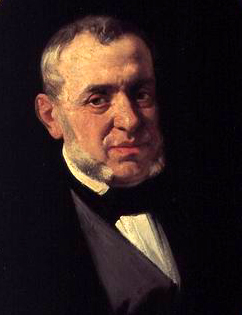
I due Figaro, o sia Il soggetto di una commedia is an opera in two acts by Saverio Mercadante to a libretto by Felice Romani based on Les deux Figaro by Honoré-Antoine Richaud Martelly. The opera was composed in 1826 but its production was delayed for some years due to censors' intervention.
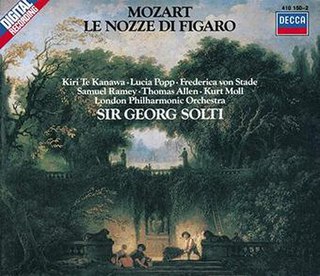
Le nozze di Figaro is a 168-minute studio recording of Wolfgang Amadeus Mozart's opera, performed by a cast of singers headed by Sir Thomas Allen, Lucia Popp, Samuel Ramey, Frederica von Stade, Kurt Moll and Dame Kiri Te Kanawa with the London Philharmonic Orchestra under the direction of Sir Georg Solti. It was released in 1982.

Le nozze di Figaro is a 169-minute studio album of Wolfgang Amadeus Mozart's opera, performed by Christiane Barbaux, Jules Bastin, Jane Berbié, Ileana Cotrubas, José van Dam, Zoltan Kélémén, Tom Krause, Marjon Lambriks, Frederica von Stade, Anna Tomowa-Sintow and Heinz Zednik with the Chorus of the Vienna State Opera and the Vienna Philharmonic Orchestra under the direction of Herbert von Karajan. It was recorded in April 1978 and released in 1979.
English Pocket Opera Company is an opera company based in the south of England. EPOC was founded in 1993 by Mark Tinkler and Annabel Lee. It works with thousands of children and young people every year in schools and other settings. EPOC has collaborated with many organisations including English National Opera, the Royal Opera House, and local music services. From 2006 until 2016, EPOC worked with design students from Central Saint Martins to create critically acclaimed and highly original opera productions.